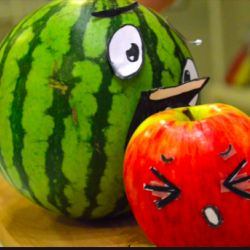Heard the one about fruit being unhealthy because it has much higher sugar levels than it did in the good ol’ days? This claim has been doing the rounds on social media, with those making it – generally fully paid up members of the low carb cult – willing to go for broke with their assertions, while offering absolutely no shred of evidence in support.
Here’s one particularly breathtaking example from a so-called MD who bills himself as a “Physician fighting to END the Chronic Disease Epidemics caused by Hyperinsulinemia”
Wow! Ken must have been feeling proper snarky that day, or he might have provided the keto crowd’s favorite “proof” that FRUIT IS PRACTICALLY CANDY: a picture of an obese monkey eating a banana. (Spoiler alert: monkeys have a much lower daily energy requirement than humans, and can easily over-consume calories from fruit, which they quite reasonably find yummy. That’s why most zoos are switching primates to a diet of leafy greens and branches, more similar to their diet in the wild).
Let’s just take a brief look at the absurdity of the 100x more sugar claim, using nothing more complicated than fifth-grade math. The only way it could be true would be if ALL ancient fruits were less than 1% by weight sugar. Highly unlikely, but let’s play along with the fiction and assume that an ancient apple, or whatever preceded it, was an implausibly low 0.75% sugar. With 100-times higher sugar, that would mean the 150 g Pink Lady I am snacking on as I write this contains 112.5 grams of sugar. Haribo-esque levels indeed, and of course this doesn’t even touch on the biological impossibility of a plant being able to concentrate this level of sugar.
Anyway, dear reader, back to Dr. Ken’s helpful suggestion. I did indeed Google it, or rather I had a good scoot around FoodData Central, which, as the name suggests, is a huge database holding the nutritional analysis of pretty much every food eaten by Americans. Unfortunately, it contains mostly the foods we are eating now, rather than what we were chowing down way back when, but it did still provide me the sugar content of “blueberries” versus “wild blueberries”. And, yup, the “modern” ones are higher in sugar with 9.96% versus 6.46% in wild blueberries, so if you are comparing these two and assuming one is the direct forerunner of the other, there’s been a 54% sugar increase.
If you prefer to have a look at UK government nutritional data, it shows no change in the sugar content of apples, white grapes, and strawberries between 1946, 1960 and now.
FoodData Central reckons “modern” super-sweet strawberries contain just 4.89% sugar, while kiwifruits are 8.99% sugar (bananas are 12.23% and lemons 2.5% sugar), illustrating that the perceived sweetness of a fruit is more than just a function of its sugar content. In fact, as botanist James Wong pointed out in a series of rather brilliant tweets refuting Dr. Ken’s claims, plant breeders traditionally make fruit taste sweeter, not by upping sugars, but by reducing sour & bitter chemicals that mask its sweetness.
What if some fruits are a bit higher in sugar these days anyway? Well yum, I say, for who would want to eat fruit that’s unpalatably sour? Fruit is delicious, it helps to bump up our fiber intake (much needed) and has a fair few phytochemicals that probably do us quite a bit of good too. Trying to scaremonger people into not eating it is ridiculous at best, and a public health issue at worst.

